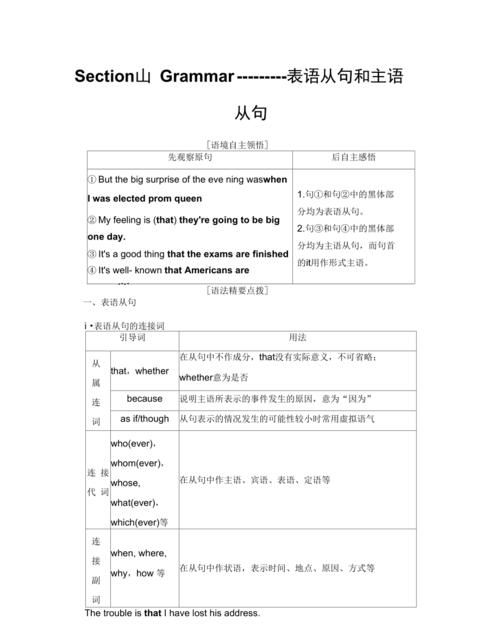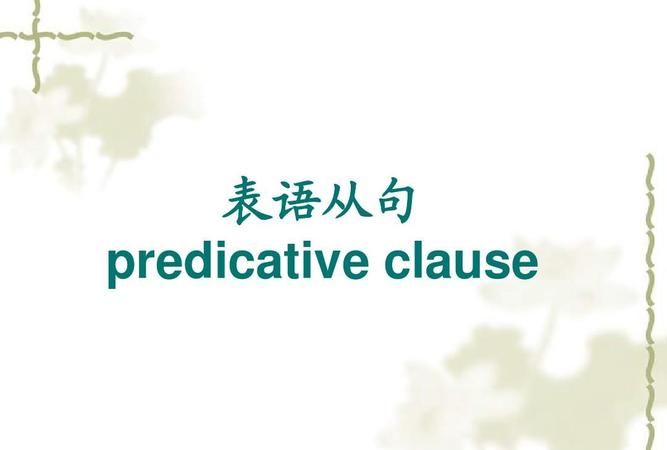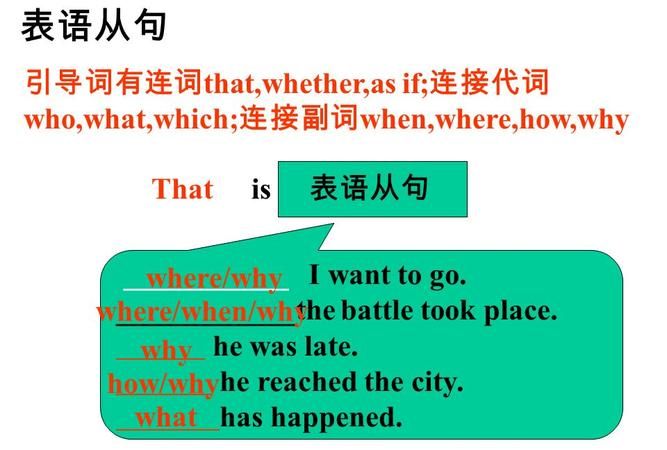本文目录
表语从句because的用法
导语: 表语从句在一个 复合句中,从句作的是主句的表语成分。下面我为您收集整理了英语表语从句的用法,希望对您有帮助!
表语从句的定义:
A. 表语从句就是用一个句子作为表语。说明主语是什么或者怎么样,由名词、形容词或相当于名词或形容词的词或短语充当,和连系动词一起构成谓语。
例句:The problem is when we can get a pay rise. 问题是,当我们可以得到加薪。
B. 连接表语从句的连接词有:that, what, who, when, where, which, why。例句:
He has become what he wanted to be ten years ago.
他已经成为了他10年前想成为的。
She has remained where I stood yesterday for an hour.
她一直在我昨天站的地方站了一个小时。
His suggestion is that we should stay calm.
他的建议是,我们应该保持冷静。
The question is when he can arrive at the hotel.
问题是,他什么时候可以到达酒店。
表语从句的.注意事项:
A. 表语从句一定要用陈述语序。
False: The question is when can he arrive at the hotel.
Right: The question is when he can arrive at the hotel.
B. 不可以用if,而用whether连接表语从句(as if 例外);
引导宾语从句时可以互换if/whether,位于介词后要用whether;
位于句首时要用whether;
引导表语从句,主语从句,同位语从句时要用whether。
False: The question is if the enemy is marching towards us.
Right: The question is whether the enemy is marching towards us.
Right: It looked as if he had understood this question.
C. 不像宾语从句,在有表语从句的复合句中,主句时态和从句时态可以不一致。
Right: The question is who will travel with me to Beijing tomorrow.
Right: The question is why he cried yesterday.
D. that在表语从句中不可以省掉。
表语从句的基本用法:
表语从句只能置于主句之后,而主句的动词只能是联系动词。
名词性从句在be等系动词后作表语时被称为表语从句,例如:
The problem is how we can get the things we need. 问题是我们怎样能弄到我们需要的东西。(how 在表语从句中充当方式状语)
The scissors are not what I need. 这把剪刀不是我所需要的。(what在表语从句中充当宾语)
What I told him was that I would find him a good play. 我告诉他的是我会给他找个好剧本。(what在主语从句中作直接宾语,that作为表语从句的引导词在该表语从句中不充当句子成分,不能省略)
That is what I want to tell you. 那就是我想要对你讲的。(what在表语从句中充当直接宾语)
That is why she failed to pass the exam. 那就是她考试不及格的原因。(why在表语从句中充当原因状语)
注意:“That is why...”是常用句型,意为“这就是……的原因/因此……”,其中why引导的名词性从句在句中作表语,该句型通常用于针对前面已经说明过的原因进行总结,又如:That is why you see this old woman before you know, Jeanne. 珍妮,这就是现在这个老太婆出现在你面前的原因。(前文提到Jeanne对老妇人显得苍老憔悴深感诧异,说话人对她讲述了其中的原因之后,用这一句来进行概括)。
下面是两个与“That is why...”形式相似的结构,它们与“That is why...”结构之间的关系要能够辨析清楚:
(1)“That is why...”与“That is the reason why...”同义,只不过从语法结构上讲,“That is the reason why...”中why引导的是—个定语从句,将其中的the reason去掉则与“That is why...”结构一样,例如:
That is (the reason) why I cannot agree. 这就是我不能同意的理由。
(2)“That is because...”句型中从属连词because引导的名词性从句在此作表语,这也是个常用句型,意为“这就是为什么……/因为……”。“That is because...”与“That is why...”之间的不同在于“That is because...”指原因或理由,“That is why...”则指由于各种原因所造成的后果, 例如:
He did not see the film last night. That is because he had to help his little sister with her homework. 昨天晚上他没有去看电影,那是因为他得帮助他的妹妹做作业。(第一句话说明结果, 第二句话说明原因)
He had seen the film before. That is why he did not see it last night. 他以前曾看过那部电影,因此他昨天晚上没有去看。(第一句话说明原因,第二句话说明结果)

表语从句常用句型
名词性从句在be等系动词后作表语时被称为表语从句, 例如: The problem is how we can get the things we need.问题是我们怎样能弄到我们需要的东西。(how 在表语从句中充当方式状语)// The scissors are not what I need. 这把剪刀不是我所需要的。(what 在表语从句中充当宾语)// What I told him was that I would find him a good play. 我告诉他的是我会给他找个好剧本。(what在主语从句中作直接宾语, that作为表语从句的引导词在该表语从句中不充当句子成分, 不能省略)// That is what I want to tell you.那就是我想要对你讲的。(what在表语从句中充当直接宾语)// That is why she failed to pass the exam. 那就是她考试不及格的原因。(why 在表语从句中充当原因状语)
注意: “That is why...”是常用句型, 意为“这就是……的原因/因此……”, 其中why引导的名词性从句在句中作表语, 该句型通常用于针对前面已经说明过的原因进行总结, 又如: That is why you see this old woman before you know, Jeanne. 珍妮, 这就是现在这个老太婆出现在你面前的原因。(前文提到Jeanne对老妇人显得苍老憔悴深感诧异, 说话人对她讲述了其中的原因之后,用这一句来进行概括)。// That is why I came. 这就是我来的原因。
下面是两个与“That is why...”形式相似的结构, 它们与“That is why...”结构之间的关系要能够辨析清楚:
(1)“That is why...”与“That is the reason why...”同义, 只不过从语法结构上讲, “That is the reason why...”中why引导的是—个定语从句, 将其中的the reason去掉则与“That is why...”结构一样, 例如:
That is (the reason) why I cannot agree. 这就是我不能同意的理由。
(2)“That is because...”句型中从属连词because引导的名词性从句在此作表语, 这也是个常用句型, 意为“这就是为什么……/因为……”。“That is because...”与“That is why...”之间的不同在于“That is because...”指原因或理由, “That is why...”则指由于各种原因所造成的后果, 例如:
He did not see the film last night. That is because he had to help his little sister with her homework.昨天晚上他没有去看电影, 那是因为他得帮助他的妹妹做作业。(第一句话说明结果, 第二句话说明原因)
He had seen the film before. That is why he did not see it last night.他以前曾看过那部电影, 因此他昨天晚上没有去看。(第一句话说明原因, 第二句话说明结果)
[考题1] The traditional view is ____ we sleep because our brain is “programmed” to make us do so. (2007上海)
A. when B. why C. whether D. that
[答案] D
[解析] 下划线处之后是包含一个原因状语从句的表语从句, 如果看不出它是充当整个句子结构的表语从句将难以把握整个句子的意思。因此, 应选择可引导名词性从句且不充当任何成分的that。
[考题2] You are saying that everyone should be equal, and this is ____ I disagree. (2004)
A. why B. where C. what D. how
[答案] B
[解析] 下划线处的引导词引导系动词is后的表语从句并在该表语从句中充当地点状语(“disagree”属于不及物动词, “I disagree”本身是完整的主谓结构), 下划线应填入引导词where, 表语从句“where I disagree”的意思是“我不同意之处、 我不同意的地方”。
[考题3] — I drove to Zhuhai for the air show last week.
— Is that ____ you had a few days off? (1999)
A. why B. when C. what D. where
[答案] A
[解析] 下划线处的引导词引导与系动词is连用的表语从句并在该表语从句中充当原因状语, 下划线应填入表示“因此……”(指因某种原因所造成的结果)的引导词why。
[考题4] ____ she couldn’t understand was ____ fewer and fewer students showed interest in her lessons. (2000上海)
A. What; why B. That; what C. What; because D. Why; that
[答案] A
[解析] 第一个下划线处的引导词引导主语从句并在该主语从句中充当宾语, 特指她所不理解的事情, 应填入关系代词型的引导词what; 第二个下划线处表示“因此……”(指因某种原因所造成的后果, 由why引导对应的名词性从句)而不是“为什么……”(指原因、 理由, 由because引导对应的名词性从句), 应填入引导词why。
[考题5] ____ made the school proud was ____ more than 90% of the students had been admitted to key universities. (2003上海春)
A. What; because B. What; that
C. That; what D. That; because
[答案] B
[解析] 第一个下划线处的引导词引导主语从句并在该主语从句中充当主语, 特指令校方骄傲的事情, 应选用关系代词型的引导词what; 第二个下划线处引导表语从句表示原因、 理由, 应由that引导对应的名词性从句。
[考题6] — Are you still thinking about yesterday’s game?
— Oh, that’s ____. (2003北京春)
A. what makes me feel excited B. whatever I feel excited about
C. how I feel about it D. when I feel excited
[答案] A
[解析] A选项的意思是“令我感觉激动的事物”; B选项的意思是“我觉得激动的任何事物”; C选项的意思是“我对它感觉的方式”; D选项的意思是“令我感觉激动的时间”。四个选项中A最适合跟代表“game”的主语that对应, 充当表语从句。

表语从句中what和who的用法
that作为表语从句的引导词在该表语从句中不充当句子成分, 不能省略)// That is what I want to tell you.那就是我想要对你讲的。
“That is why...”与“That is the reason why...”同义, 只不过从语法结构上讲, “That is the reason why...”中why引导的是—个定语从句, 将其中的the reason去掉则与“That is why...”结构一样, 例如:That is (the reason) why I cannot agree. 这就是我不能同意的理由。
“That is because...”句型中从属连词because引导的名词性从句在此作表语, 这也是个常用句型, 意为“这就是为什么……/因为……”。“That is because...”与“That is why...”之间的不同在于“That is because...”指原因或理由, “That is why...”则指由于各种原因所造成的后果

表语从句英语句子
表语从句英语语法
英语语法—从句—表语从句

1.在句子中起表语作用的从句叫做表语从句。表语从句的引导词和主语从句的引导词相同。
What the police want to know is when you entered the room.
警察想知道的是你什么时候进的房间。
The trouble is that we are short of funds. 困难是我们缺乏资金。
That's why I want you to work there. 那就是我要你在那儿工作的原因。
His first question was whether Mr. Smith had arrived yet.
他的第一个问题是史密斯先生到了没有。
as if, as though, because也可用来引导表语从句。
She seems as if she had done a great thing. 她看起来好像做了一件大事。
It is because you eat too much. 那是因为你吃得太多了。
2.虚拟语气:表语从句
主语是idea, notion, proposal, suggestion, request等名词时, 作表语从句的动词为原形动词或should+原形动词。
My suggestion is that we (should) go and help him. 我的建议是我们应该去帮助他。
Our only request is that this should be settled as soon as possible.
我们唯一的请求就是尽快解决这个问题。
英语语法—从句—状语从句
1.状语从句在句子中起状语作用的从句叫做状语从句。状语从句由从属连词引导。状语从句可分为:
时间状语从句:
When Susan goes to town, she will visit her grandma.
苏珊每次进程,总要去看望她奶奶。
地点状语从句:
I will go where I am needed. 哪里需要我,我就到哪里去。
方式状语从句:
I have changed it as you suggest. 我已经按照你的建议作了改变。
原因状语从句:
Mary didn’t go shopping because I advised her not to.
玛丽没有去购物,因为我劝她不要去。
目的状语从句:
They worked hard in order that they might succeed.
他们努力工作,以便能够获得成功。
结果状语从句:
Waste must be treated so that it does not become a danger to life.
废物必须进行处理,这样它才不会成为危害生命的东西。
条件状语从句:
If he works hard, he will surely succeed. 如果努力工作,他肯定会成功。
让步状语从句:
Though we are all different, we need never be separate.
比较状语从句:
I was happier than I had ever been in my life. 这是我一生中最快乐的时光。
2.时间状语从句:after
时间状语从句由下列连词引导:After, as, before, once, since, till, until, when, whenever, while, as soon as
Let's wait till the rain stops. 咱们等到雨停再说吧。
Once the train is moving, there's no way to stop it.
火车一旦开动就没办法让它停下来。
They were scolded whenever they were late for school. 每次他们上学迟到都挨骂。
3.时间状语从句:the moment
有一些表示时间的名词短语也可用来引导时间状语从句:The minute, the moment, every time, the first time
The moment he reached the country, he started his search.
他一到达这个国家,就开始他的探寻工作。
Every time I saw the straw hat, it reminded me of the tour I made years before.
每当我看到那顶草帽,它就使我想起几年前的那次旅游。
I thought her nice and honest the first time I met her。
我第一次见到她就觉得她诚实而友善。
4.时间状语从句:directly
有一些表示时间的副词也可用来引导时间状语从句:
Directly the master came in, everyone was quiet. 校长一进来, 大家就安静下来。
The young lady rushed into the room immediately she heard the noise.
那位年轻女士一听到响声就冲进房间。
5.时间状语从句:as的用法
1).某事一发生,另一事立即发生
As the sun rose the frog dispersed. 太阳一出来雾就消散。
They strolled into the garden as the music ceased. 音乐声一停,他们就走进花园。
2).在某事发生的过程中另一事发生
I heard the murmur of their voices as I crossed the hall. 我走过大厅的时候听到他们在嘀咕什么。(两个动作都是一般时态)
Just as he was speaking there was a loud explosion. 正当他在说话的时候,一声巨响。
(从句用进行时态)
3).两个动作同时发生
He smiled as he passed. 他路过的时候笑了一下。(两个都是短暂动作)
As she sang, the tears ran down her cheeks. 她一边唱歌,眼泪一边从脸颊淌下。
Helen heard the story as she washed. 海伦一边洗衣服一边听故事。
He saw that she was smiling as she read.
他看到她一边看着书一边笑。(两个都是延续性动作)
We get wiser as we get older.
我们随着年龄的增长而变得聪明起来。(随着时间的变化而变化)
6.时间状语从句:when的用法
以when引导的时间状语从句中,既可用短暂性动作也可用延续性动作。
I bought the car when I received my first salary.(短暂性动作)我是在领第一笔薪水的时候买的车。
Don't get excited when you talk.(延续性动作)说话的时候不要激动。
7.when 容易与时间状语从句混淆的例子
请注意:此项中when引导的都不是时间状语从句。
She had just finished dressing when her guests came in.
她刚刚穿戴完毕,这时她的客人进来了。
这里的when不是从属连词,而是并列连词。所以它引导的是并列句。像这类问题有以下主要特征:
when 后面的分句动词必须是瞬间动词,用于表示突然性:
We were about to start when it began to rain.正当我们要出发的时候,突然下雨了。
1).when 前面的分句是过去进行时:
He was still smiling when the door opened and his wife came in.
他正笑着,突然门开了,他的妻子走了进来。
2).when 前面的分句含有be about to, be on the point of:
He was on the point of leaving when someone knocked at the door.
他正要出发的时候,突然有人敲门。
3).when 前面的分句采用过去完成时或是过去完成进行时:
We had just fallen asleep when the telephone rang.
我们刚刚入睡,突然电话铃声响了。
The plane had been planting seed for nearly a month when it began to rain.
飞机播种了近一个月,这时天才下雨。
8.时间状语从句:while的用法
以while引导的时间状语从句中,只能用延续性动作。
They arrived while I was sunbathing. 当我正在进行日光浴时,他们来了。
While the discussion was still going on, Mr. Zhang came in.
当讨论还在进行的时候,张先生进来了。
9.原因状语从句
because, as, since, 用来引导原因状语从句。for虽然也是表示原因,但是它不是从属连词,而是并列连词。
because 表示最强的因果关系,表达听话者未知的原因,because引导的从句通常放在后面,表示强调时也可放在前面。because引导的从句可以用来回答Why引起的特殊疑问句。
He got the job because he was the best candidate.
他得到那份工作,因为他是最佳人选。
“Why can’t I go?”“Because you are too young.”
为什么我不能去?因为你年纪太小。
as 所表示的原因通常是听话者已经知道的。因而它不是句子的中心。不能用来回答Why引起的特殊疑问句。
As all the seats were full, he stood up. 由于所有的座位都满了,他只好站着。
Perhaps she’ll need some help, especially as she’s been ill.
她可能需要帮助,尤其是因为她一直有病。
since所表示的原因通常也是听话者已经知道的。同样since也不能用来回答Why引起的特殊疑问句。
Since you are going, I will go too. 既然你要去,我也去吧。
for 从语法分析的角度来说,它不是引导状语从句,而是构成一个并列句。 for 通常用于书面语,它通常不表示因果关系,而是对前面的分句进行补充说明。for-分句通常放在句末,for 之前有逗号。
He laughed little, for he was a sad man. 他很少发笑,因为他是个多愁的人。
She was clearly upset, for her eyes were filled with tears.
她显然心烦意乱,因为她眼眶里饱含泪水。
10.地点状语从句
地点状语从句通常由where,wherever引导。
Where he made mistakes, he admitted these willingly.
他在什么地方做错了事,他都乐于承认这些错误。
Put it where we can see it. 把它放在我们能看得见的地方。
Let’s go wherever this path will take us.
我们就顺着这条小路走,走到哪儿就算哪儿。
英语语法 - 同位语从句
1.同位语从句:whether
whether可以引导同位语从句,而定语从句不能用whether作为引导词。
He hasn’t made the decision whether he will go there.
他还没有做出决定是否去那里。
I have small doubt whether he is suitable for the job.
他是否适合这件工作我有点怀疑。
2.同位语从句:that
些名词的后面可以接that引导的`同位语从句:
We came to the decision that we must act at once. 我们做出决定:我们必须立即行动。
He made a proposal that the meeting be postpone. 他提议会议延期。
There was little hope that he would survive. 他幸存的希望很小。
在非正式语体中that可以省略。
以下名词常用于以上句型:
advice, announcement, argument, belief, claim, conclusion, decision, evidence, explanation, fact, feeling, hope, idea, impression, information, knowledge, message, news, opinion, order, probability, promise, proposal, remark, reply, report, saying, statement, suggestion, thought, treat, warning, wish, word
3.同位语从句:what
what可以引导同位语从句,而定语从句不能用what作为引导词
I have no idea what he is doing now. 我不知道他现在在干什么。
4.同位语从句:how
how可以引导同位语从句,而定语从句不能用how作为引导词
It’s a question how he did it. 那是一个他如何做了此事的问题。
5.同位语从句:who等
who, whom, which, when, where, why用来引导同位语从句
The question who should do the work requires consideration.
谁该干这项工作,这个问题需要考虑。
She raised the question where we could get the fund.
她提出这个问题:我们到哪儿去搞这笔资金。
6.同位语从句和定语从句的区别
1)同位语从句和先行词是同等的关系;而定语从句是用来修饰先行词,是从属的关系。
2)that在同位语从句中没有词义,不充当句子成分;而在定语从句中充当主语、宾语等句子成分。
3)whether, what, how可以用来引导同位语从句;而它们不能用来引导定语从句。
4)1. 从词义角度看问题
who, whom, which, when, where, why用来引导同位语从句是保持原来疑问词的含义;它们用来引导定语从句时,不具有疑问词的含义。
2.从搭配角度看问题
who, whom, which, when, where, why用来引导定语从句时对应性很强,如:先行词是“人”,引导词用“who”等,而它们引导同位语从句是先行词通常是“question, idea, doubt等”。
英语语法—从句—定语从句
1.定语从句在句子中作定语,用来修饰一个名词、名词词组或者代词
2.先行词和引导词
被修饰的名词、名词词组或代词叫做先行词;在先行词和定语从句之间起连接作用的词叫做引导词。引导词语可分为“关系代词”和“关系副词”。
3.关系代词和关系副词
关系代词有:who, whom, whose, that, which, as。关系副词有:when, where, why。
<注意:关系副词里面没有how。如果要修饰方式,用that或in which引导,或者不用引导词。
I don’t like the way (that, in which) he eyed me. 我不喜欢他看我的那个样子。
4.关系代词:who
关系动词who在从句中主要作为主语,在非正式语体里who还可以作从句中的宾语。
He is the man who wants to see you. 他就是想要见你的那个人。(who在句中作为主语)
Succeed will come to him who is honest and diligent. 成功将归于诚实而勤奋的人。
5.关系代词:whom
He is the man whom I saw in the park yesterday.
他就是我昨天在公园里见到的那个人。(whom在从句中作宾语)
作宾语用的引导词可以省略,因此上面的句子可以改写如下:He is the man I saw in the park yesterday.
6.关系代词:whose用来指人或物(只能用作定语, 若指物,它还可以同of which互换)。
They rushed over to help the man whose car had broken down.
那人车坏了,他们跑过去帮忙。
Please pass me the book whose (of which) cover is green. 请递给我那本绿皮的书。
7.关系代词:which(1)
which指物,在从句中作为主语或宾语,作宾语时在非正式语体中可以省略。
They needed a plant which didn't need as much water as rice.
他们需要一种不像水稻那么需要水的作物。(主语)
The farm (which) we visited yesterday is located in the suburb of Beijing.
我们昨天参观的农场位于北京郊区。(作宾语,可省略。)
8.关系代词:which(2)
当在which和that面前进行选择的情况下,一下情况要选which:
1).在非限制性定语从句中通常用which作引导词,而不能用that做非限制性定语从句的引导词。
2). 修饰整个主句。
I never met Julia again after that, which was a pity.
从那以后我再也没有见到朱莉叶,真是遗憾。
3). 修饰谓语部分。
He can swim in the river, which I cannot. 他会在河里游泳,那正是我不会的。
4). 介词 + which
They are all questions to which there are no answers. 那些问题都是无头公案。
9.关系代词:that(1)
that多用来指物,有时也可以用来指人;在从句中作主语或宾语。
指物的时候多用that,也可用which。
It’s a question that (which) needs careful consideration.
这是一个需要仔细考虑的问题。(指物,作为主语。)
Who is the man that is reading a magazine under the tree?
树下那个在看杂志的那个人是谁?(指人,作为主语。)
The girl (that) we saw yesterday is Tom’s sister.
我们昨天看到的那个女孩是汤姆的妹妹。(指人,作宾语,可省略。)
10.关系代词:that(2)
在以下的情况中,只能用that作引导词,而不能用which作引导词。
1). 先行词为all , everything, anything, nothing, little等不定代词时。
All that she lacked was training. 她所缺少的是训练。
everything等为先行词时,引导词可以省略。
Have you everything you need? 你要的东西都有了吗?
Is there anything I can do for you? 有什么事要我做吗?
All you have to do is to press the button. 你所要做的就是按一下电钮。
2). 先行词被形容词最高级修饰时
This is the best film that I have ever seen. 这是我看过的电影中最好的一部。
3). 先行词被序数词和the last修饰时
4). 先行词中既有人又有物时
They talked about the teachers and the schools that they had visited.
他们谈论他们参观过的那些学校和老师们。
5). 主句是含有who或which的特殊疑问句,为了避免重复时
英语语法—从句—宾语从句
1.在句子中起宾语作用的从句叫做宾语从句。宾语从句的引导词和主语从句的引导词相同。宾语从句可以作及物动词的宾语,作短语动词的宾语,介词的宾语。
2.宾语从句:短语动词
Please go and find out when the train will arrive. 请去弄清楚火车什么时候到。
His teacher pointed out that Tom hadn't studied hard enough.
老师指出汤姆学习不够努力。
That depends on how you do it. 那得看你怎么做的。
3.宾语从句:及物动词
Everybody knows that money doesn't grow on trees. 谁都知道钱不是长在树上。
Have you decided where you will go for a holiday? 你有没有决定到什么地方去度假?
4.宾语从句:介词的宾语
I am curious as to what they are going to do next.
我对他们下一步打算做什么很感兴趣。
The twin sisters differ only in that one is a bit fatter than the other one.
这对双胞胎姐妹的区别,仅仅在于其中一个比另一个稍胖一点。
I am interested in what she is doing. 我对她做的事感兴趣。
5.宾语从句:否定的转移
有些表示思想和感情的动词之后的宾语从句中的否定式可以注意到这些动词之前。
I don't suppose you're used to this diet. = I suppose you aren't used to this diet.
我想你不习惯这种饮食。
I didn't expect she would pass the entrance examination. = I expected she wouldn't pass the entrance examination. 我以为她不能通过入学考试。
6.虚拟语气:宾语从句
一些含有假设、猜想、建议等意思的动词后面的宾语从句要用should+原形动词结构,should往往可以省略。这类动词有: advice, arrange, command, demand, desire, insist, order, propose, require, request, suggest等。
I suggested that he study harder. 我建议他用功一些。(这一题要特别注意:为什么study用原形。)
I insisted that he (should) go. 我强调他应当去。
7.宾语从句的省略
引导宾语从句的that之后接的从句不长时,可以省略。如果that后面的宾语从句较长时,that不能省略。
I hope (that) you'll be fine soon. 我希望你尽快康复。
英语语法—从句—主语从句
1.以what等连接代词引导的主语从句
What you need is more practice. 你需要的是更多的练习。
Whoever wants it may have it. 谁要都可以给他。
同类的连接代词还有:What, who, whom, whose, which, whatever, whoever, whichever
2.以that, whether从属连词引导的主语从句
It was strange that he had made a mistake. 真奇怪,他竟然错了。
That we need more equipment is quite obvious. 我们需要更多的设备,这是很明显的。
Whether he will join us won't make too much difference.
他是否加入我们,没有太大的差别。
3.主语从句的引导词that什么时候可以省略
当主语从句不太长时,引导词“that”可以省略
It's clear (that) he has done his best. 很明显他已经尽力而为了。
It's a wonder (that) he didn't fail. 真奇怪,他没有失败。
4.以when等连接副词引导的主语从句
When they will come hasn't been made public. 他们什么时候来还没有公布。
Where she has gone is not known yet. 她去了哪儿,还不知道。
Why he did it will remain a puzzle for ever. 为什么他做那件事将永远是个谜团。
5.虚拟语气:主语从句
形容词为necessary, important, impossible, strange, natural, essential时,在“It + be + 形容词或过去分词 + 主语从句”中,主语从句要虚拟。
It is necessary that the problem (should) be discussed at once.
立刻讨论这个问题很有必要。
It is strange that he (should) have so many friends. 太奇怪了,他有那么多的朋友。
6.主语从句与强调句的区别
注意事项:
1). 在主语从句中,把It was … that去掉之后,就已经完全不像一个句子了。
2). 在强调句中,把It was … that去掉之后,还基本上像个句子。
3). 主语从句有以下的引导词:what, who, whom, whose, which, whatever, whoever, whichever
4). 强调句的引导词只有:that, who。
主语从句:
It was strange that he had made a mistake. 如果把,It was … that 去掉以后,剩下strange he had made a mistake.就不算是句子了。
It is immaterial where or when he goes. 他去何处或者何时去是无关紧要的。
<<It is said that…, 和It is reported that…这样的结构,后面接的是主语从句:
It is said that he’s got married. 听说他已经结婚了。
强调句:
It was she that had been wrong. 错的是她。(强调主语)如果把,It was … that 去掉以后,剩下she had been wrong.还勉强算的上是一个句子。
It was this novel that they talked about last night. 他们昨晚谈论的是这部小说。(强调宾语)
It was in London that I first saw her. 我是在伦敦第一次见到她的。(强调地点状语)
;以上就是关于表语从句引导词用法详细,表语从句because的用法的全部内容,以及表语从句引导词用法详细 的相关内容,希望能够帮到您。
